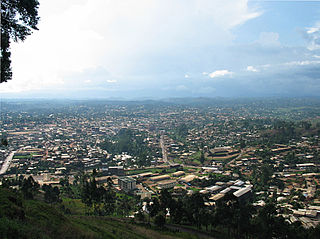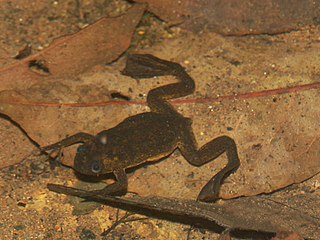
The Northwest Region, or North-West Region is one of ten regions of Cameroon. Its regional capital is Bamenda. The Northwest Region was part of the Southern Cameroons, found in the western highlands of Cameroon. It is bordered to the southwest by the Southwest Region, to the south by the West Region, to the east by the Adamawa Region, and to the north by Nigeria. Various Ambazonian nationalist and separatist factions regard the region as being distinct as a polity from Cameroon.

Bamenda, also known as Abakwa and Mankon Town, is a city in northwestern Cameroon and capital of the Northwest Region. The city has a population of about 2 million people and is located 366 km (227 mi) north-west of the Cameroonian capital, Yaoundé. Bamenda is known for its cool climate and scenic hilly location.
Articles related to Cameroon include:

Kumbo, also known as Kimbo, is the second-largest city in the North West Province of Cameroon and the capital of Bui Division. It lies about 2000m above sea level and is situated approximately 110 km away from Bamenda, on the Bamenda Highlands Ring Road. Kumbo has a population of 80,212 and is split into three distinctive hilly settlements of Tobin, Mbveh, and Squares. The town is known for horse racing and traditional medicine, and also for its palace, a market and two hospitals. Kumbo is the capital city of the Nso Kingdom of the Nso people. The lingua franca is Lamnso but Pidgin, English, Oku, Djottin, Fulfulde, French and Hausa are spoken.

The Kilum-Ijim Forest is an area of mountain rainforest in Cameroon's North-West Region. It is found on Mount Oku and the nearby Ijim Ridge in the Cameroon mountains, with Lake Oku lying in a crater in its center. It is the largest area of Afromontane forest left in West Africa. The area is an important one for biodiversity, including the endemic Bannerman's turaco and banded wattle-eye. The forest is the focus of a successful community conservation project, the Kilum-Ijim Forest Project, which works to protect the forest. The project is a collaboration between the Cameroon Ministry of the Environment and BirdLife International, and focuses on sustainable use of the forests, local management, working to benefit both the biodiversity and local development. The programme works so well that the boundaries of the forest, as mapped by satellite imagery, are expanding, and the success of the idea has led to another sister project in Cameroon, the Bamenda Highlands Forest Project.
The Nso people are from the Bamenda grass fields Northwest Region of Cameroon. Their traditional language is Lamnso and their capital is Kumbo – where the Palace of the Fon is found.

The Cameroon line is a 1,600 km (1,000 mi) long chain of volcanoes that includes islands in the Gulf of Guinea and mountains on the African mainland, from Mount Cameroon on the coast towards Lake Chad on the northeast. They form a natural border between eastern Nigeria and the West Region of Cameroon. The islands, which span the equator, have tropical climates and are home to many unique plant and bird species. The mainland mountain regions are much cooler than the surrounding lowlands, and also contain unique and ecologically important environments.

The Cameroonian Highlands forests, also known as the Cameroon Highlands forests, are a montane tropical moist broadleaf forest ecoregion located on the range of mountains that runs inland from the Gulf of Guinea and forms the border between Cameroon and Nigeria. This is an area of forest and grassland which has become more populous as land is cleared for agriculture.

The Western High Plateau, Western Highlands or Bamenda Grassfields is a region of Cameroon characterised by high relief, cool temperatures, heavy rainfall and savanna vegetation. The region lies along the Cameroon line and consists of mountain ranges and volcanoes made of crystalline and igneous rock. The region borders the South Cameroon Plateau to the southeast, the Adamawa Plateau to the northeast and the Cameroon coastal plain to the south.

The Roman Catholic Diocese of Kumbo is a Roman Catholic diocese in the Ecclesiastical Province of Bamenda in Cameroon. The first German settlers were Missionaries of the Sacred Heart who arrived in 1912 and established their mission in 1913. The Diocese of Kumbo was erected by Pope John Paul II on Thursday, 18 March 1982, with territory taken from the then Diocese of Bamenda. It is a suffragan diocese of the Metropolitan See of Bamenda along with the Roman Catholic Dioceses of Buea, Kumba, and Mamfe.

The Lake Oku clawed frog is a species of frog in the family Pipidae, endemic to Lake Oku, a small crater lake in northwest Cameroon. It is a small, dark-coloured, fully aquatic frog with a length of 28 to 36 mm, males being slightly smaller than females. The International Union for Conservation of Nature has rated this frog as "critically endangered" on the basis of its small area of occurrence at a single location, and the possibility that introduction of non-native fish into the lake could cause the frog to be wiped out.

Mount Oku, or Kilum Mountain, is the largest volcano in the Oku Massif, in the Cameroon Volcanic Line, located in the Oku region of the Western High Plateau of Cameroon. It is the second highest mountain in mainland Central Africa. The stratovolcano rises to 3,011 metres (9,879 ft) above sea level, and is cut by a large caldera.

The Menchum River and its tributaries drains a large area of the Northwest Region of Cameroon. It in turn is a tributary of the Benue River in Nigeria.

Lake Oku is a crater lake on the Bamenda Plateau in the Northwest Region of Cameroon. It is located at 2,227 metres (7,306 ft) on Mount Oku, and is completely surrounded by cloud forest.
This is a timeline of the Anglophone Crisis during 2018.
This is a timeline of the Anglophone Crisis during 2020.
This is a timeline of the Anglophone Crisis during 2021.
This is a timeline of the Anglophone Crisis in Cameroon during 2022.












